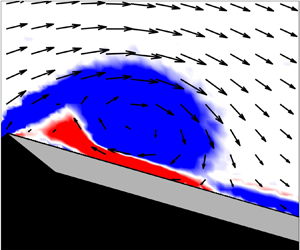Crossref Citations
This article has been cited by the following publications. This list is generated based on data provided by
Crossref.
Feng, Li-Hao
Li, Zhen-Yao
and
Chen, Yi-Long
2020.
Lift enhancement strategy and mechanism for a plunging airfoil based on vortex control.
Physics of Fluids,
Vol. 32,
Issue. 8,
Kissing, Johannes
Wegt, Sebastian
Jakirlic, Suad
Kriegseis, Jochen
Hussong, Jeanette
and
Tropea, Cameron
2020.
Leading edge vortex formation and detachment on a flat plate undergoing simultaneous pitching and plunging motion: Experimental and computational study.
International Journal of Heat and Fluid Flow,
Vol. 86,
Issue. ,
p.
108726.
Xiang, Yang
Hang, Haotian
Qin, Suyang
and
Liu, Hong
2021.
Scaling analysis of the circulation growth of leading-edge vortex in flapping flight.
Acta Mechanica Sinica,
Vol. 37,
Issue. 10,
p.
1530.
Wang, Wei
Cao, Shengli
Dang, Nannan
Zhang, Jiazhong
and
Deguchi, Yoshihiro
2021.
Study on dynamics of vortices in dynamic stall of a pitching airfoil using Lagrangian coherent structures.
Aerospace Science and Technology,
Vol. 113,
Issue. ,
p.
106706.
Wang, Lei
Feng, Li-Hao
Liang, Yan
Chen, Yi-Long
and
Li, Zhen-Yao
2021.
Vortex control strategy for unsteady aerodynamic optimization of a plunging airfoil at a low Reynolds number.
Physics of Fluids,
Vol. 33,
Issue. 11,
Wang, Tong
Feng, Li-Hao
and
Li, Zhen-Yao
2021.
Effect of leading-edge protuberances on unsteady airfoil performance at low Reynolds number.
Experiments in Fluids,
Vol. 62,
Issue. 10,
Brousseau, Paul
Benaouicha, Mustapha
and
Guillou, Sylvain
2021.
Fluid-structure interaction effects on the deformable and pitching plate dynamics in a fluid flow.
Applied Ocean Research,
Vol. 113,
Issue. ,
p.
102720.
Bao, Han
Song, Bifeng
Yang, Wenqing
and
Xue, Dong
2021.
The function of the alula with different geometric parameters on the flapping wing.
Physics of Fluids,
Vol. 33,
Issue. 10,
Brousseau, P.
Benaouicha, M.
and
Guillou, S.
2022.
Investigation on the hydrodynamic load fluctuations through passive flexible leading edge.
Physics of Fluids,
Vol. 34,
Issue. 10,
Suresh Babu, Arun Vishnu
Narsipur, Shreyas
Bryant, Matthew
and
Gopalarathnam, Ashok
2022.
Leading-edge-vortex tailoring on unsteady airfoils using an inverse aerodynamic approach.
Physics of Fluids,
Vol. 34,
Issue. 5,
Li, Xiao
and
Feng, Li-Hao
2022.
Critical indicators of dynamic stall vortex.
Journal of Fluid Mechanics,
Vol. 937,
Issue. ,
Xing, Shi-Long
Xu, He-Yong
Zhang, Wei-Guo
and
Delibra, Giovanni
2022.
Trailing Edge Flap Effects on Dynamic Stall Vortex and Unsteady Aerodynamic Forces on a Pitching Airfoil.
International Journal of Aerospace Engineering,
Vol. 2022,
Issue. ,
p.
1.
Ma, Xingyu
Gong, Xuan
Tang, Zhanqi
and
Jiang, Nan
2022.
Control of leading-edge separation on bioinspired airfoil with fluttering coverts.
Physical Review E,
Vol. 105,
Issue. 2,
Gonçalves, Sullivan B.
Camacho, Emanuel A.
and
Silva, Andre R.
2022.
Influence of Trailing-Edge Shape on the Propulsive Performance of a Plunging Flat Plate.
WU, Tao
SONG, Bifeng
SONG, Wenping
YANG, Wenqing
XUE, Dong
and
HAN, Zhonghua
2022.
Lift performance enhancement for flapping airfoils by considering surging motion.
Chinese Journal of Aeronautics,
Vol. 35,
Issue. 9,
p.
194.
Adhikari, Dibya Raj
Loubimov, George
Kinzel, Michael P.
and
Bhattacharya, Samik
2022.
Effect of wing sweep on a perching maneuver.
Physical Review Fluids,
Vol. 7,
Issue. 4,
Guo, Pengming
Kaiser, Frieder
and
Rival, David E.
2023.
Dynamic separation on an accelerating prolate spheroid.
Journal of Fluid Mechanics,
Vol. 975,
Issue. ,
Kasmaiee, Sa.
Tadjfar, M.
and
Kasmaiee, Si.
2023.
Machine learning-based optimization of a pitching airfoil performance in dynamic stall conditions using a suction controller.
Physics of Fluids,
Vol. 35,
Issue. 9,
Martínez-Muriel, C.
Arranz, G.
García-Villalba, M.
and
Flores, O.
2023.
Fluid–structure resonance in spanwise-flexible flapping wings.
Journal of Fluid Mechanics,
Vol. 964,
Issue. ,
Li, Zhen-Yao
Feng, Li-Hao
Wang, Tong
and
Liang, Yan
2023.
Lift generation mechanism of the leading-edge vortex for an unsteady plate.
Journal of Fluid Mechanics,
Vol. 972,
Issue. ,
